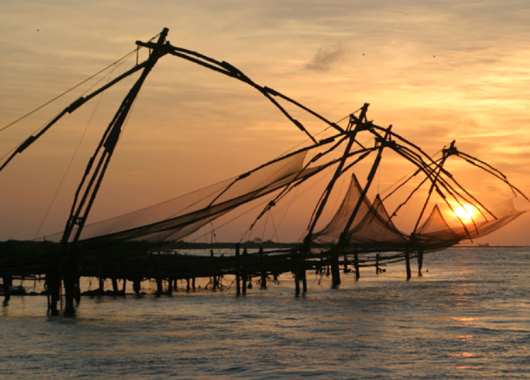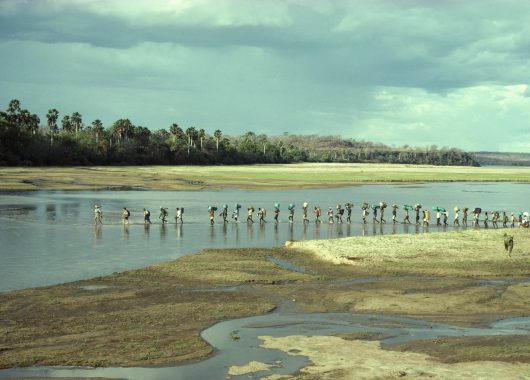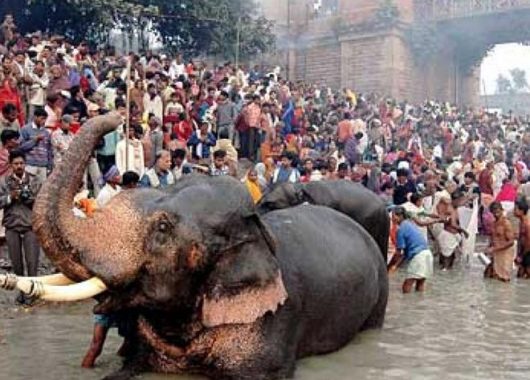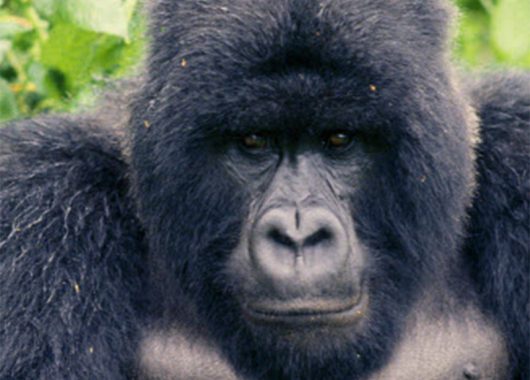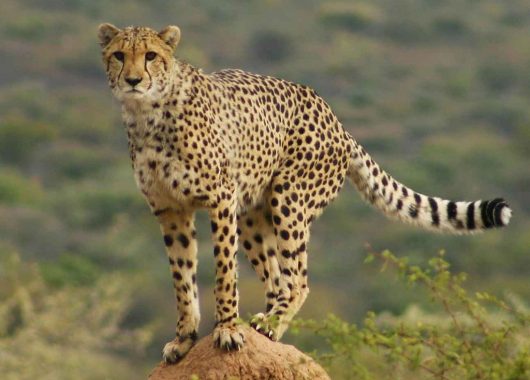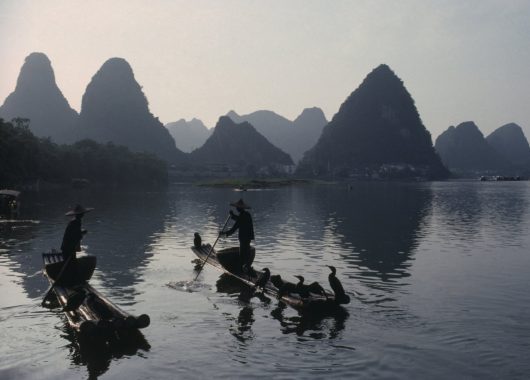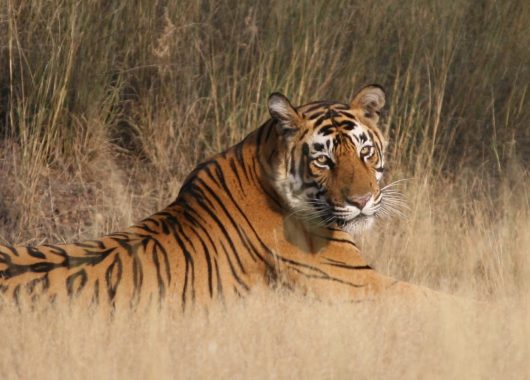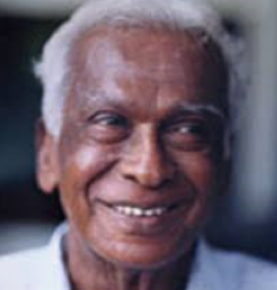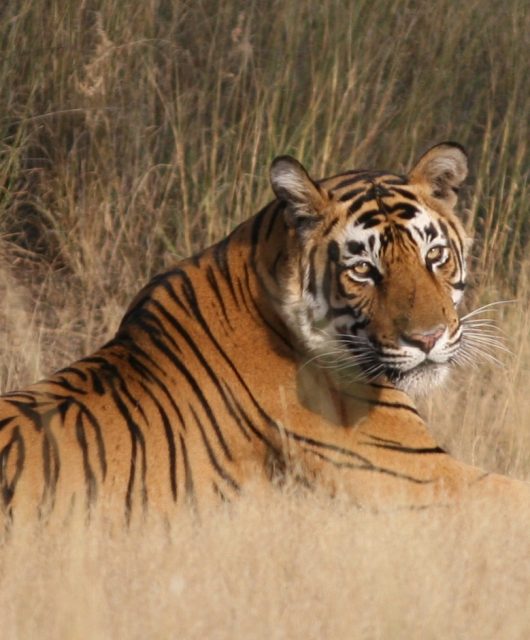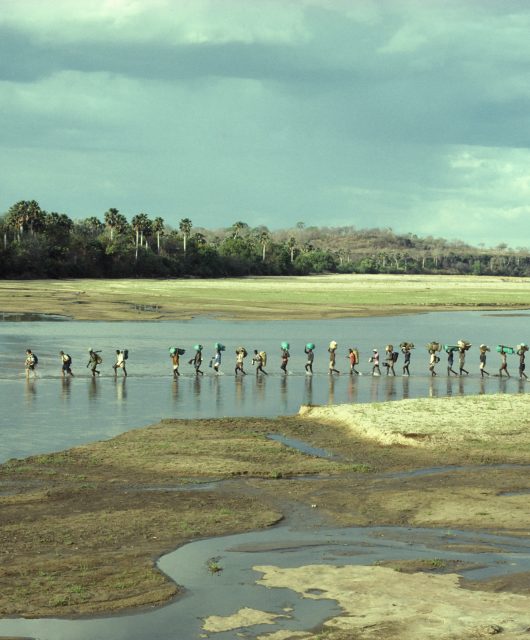The Honey Guide
This article originally appeared in the May 1997 edition of Harpers and Queen.
During a walking safari in Zambia my guide pointed to a small sparrow-like bird, then told me an incredible story. He said that this nondescript little creature, the Greater Honeyguide, uses a human assistant to obtain its favourite food, beeswax. The birds are too small to break into the bees’ nests by themselves, so they search for someone to help. This helper breaks into the nest, takes away the honey, and leaves behind a morsel of wax for the bird.
If my guide’s story was accurate, this must be one of the most extraordinary symbiotic relationships between man and a wild animal. Ever since the Zambian trip I had wanted to know more, but discovered that there was minimal literature on the subject. It wasn’t until I was planning my most recent safari that the librarian of the Alexander Library gave me the exciting news that a Kenyan, Hussein Adan Isack, had recently submitted a remarkable thesis on Honeyguides. Accompanied by armed guards, Isack had studied the birds for months on end in the bandit-infested regions of northern Kenya. Having read his descriptions, I now knew my Zambian guide’s story hadn’t been exaggerated, and I decided to search for Honeyguides in Botswana, a country where no armed guards would be likely to be necessary.
Before my departure I spent countless hours in camera shops trying to select a telephoto lens that was powerful without being too heavy. Its main purpose was to photograph the Honeyguide, but I was also determined that, for once, any cheetah in my photographs wouldn’t resemble a distant tabby cat. Eventually an astute assistant sold me a lens which was the length and weight of a missile launcher, and nearly as expensive. As it happened, all my efforts turned out to be wasted: the little bird remained resolutely just out of range, while the larger animals came so close that, unless I backed away from them, the costly lens showed only a lion’s nostril or the eyelash of an elephant.
Indeed days before finding my first Honeyguide I had an experience of remarkable proximity to some large animals. On my very first evening in the bush I was sitting with five other guests at the edge of Lloyd Wilmot’s camp in the parched landscape of northern Botswana. We were watching six elephants drinking in the sandy channel just below us. The whole scene was lit like a stage-set by the full moon. Suddenly the rumbles and gurgles of the elephants ceased: three lionesses had appeared from the right and were walking steadily towards them. The elephants shrieked with anger.
The lionesses tried to mock charge, but after failing to budge the elephants from their water, they continued along the channel, and then turned left. I presumed this must be a mistake, as their path would now lead them among our tents. Soon our guide stood up and shone his torch along the edge of the camp. The beam was reflected by three distant pairs of eyes.
He told us to stop talking and to turn off torches, while his own was kept fixed on the three lionesses, who now began to advance. When would they realise their mistake, I kept wondering. But on they came, closer and closer. Finally they halted only fifteen feet from our awestruck little gathering. They then turned to one side and drank noisily from a sunken birdbath. While they were drinking, the guide asked in a whisper whether any of us had a camera. He then grabbed a little Instamatic, crawled to within seven feet of one of the lionesses and took a flash photograph. She turned towards him and snarled, giving a clear view of the pink inside of her mouth.
Lloyd Wilmot, the camp’s owner, has had even closer encounters. In earlier years few of his clients had telephoto lenses, therefore Lloyd would get out of a jeep (this was permitted before the area became a wildlife reserve) and crawl through the undergrowth, trying to attract the lions closer by imitating the movements of potential prey. One of the resulting photographs shows eight inquisitive lionesses facing him in a semicircle. In another astounding photograph his face is so close to a lion that he must have been able to smell its breath.
I asked Lloyd, who unlike some guides doesn’t try to be macho, how he had developed this ability to approach so close to lions, and whether he had ever felt in danger. He said that his most frightening moment was when a lioness charged, attempting to flush him out of the long grass. He stood his ground, and hurled a clump of earth. This unexpected missile halted the attack. Lloyd has also become an expert at judging lions’ moods from their expressive eyes. A lion can subdue a bumptious cub by doing no more than simply giving it a stern glance. After this conversation I noticed that even a beginner like me could recognise a lion’s different moods, just as one can with a dog or a human being.
In this remote area of north Botswana it isn’t only the lions that are at ease with man. Every night a procession of elephants stepped almost silently past my tent. They were so close that, as I lay in bed looking through the gauze window, I could see only up to their knees. Even in the middle of the day when I read outside my tent, the elephants passed just a few yards away, pausing with raised trunks to sniff in my direction.
I discovered that it was possible to get even closer. A guide took me down to a ledge just above the water-hole where we had watched them on my first night. As usual in this dry season there was a crowd of elephants. One of them pressed against the ledge and lifted its head until its tusk touched my shoe. The guide took off his sandal and smacked the animal on the trunk. It wheezed, retreated a few steps, and continued to drink.
You can probably get closer to a wild elephant at Lloyd’s Camp than anywhere else in the world; and Lloyd Wilmot may be unique in his familiarity with wild lions. Is there a reason for the remarkable tameness of animals in northern Botswana? They would never, of course, be so tame if they were hunted. And I believe it is significant that in this region, which has always been very remote, the animals have no ancestral memories of being hunted.
In some ways Honeyguides appear to be even tamer than the large animals, for they positively seek us out. But in fact they are neither tame nor wild: where there isn’t a bees’ nest to guide us to, they fly away from us. They have learned to use man, instead of man using them. The relationship is unique.
We have no idea when the birds developed this extraordinary instinct for guiding. It is doubly extraordinary for birds to do this, for a more usual instinct is to lead us away from something, mostly their nests or fledglings. The first written description of guiding was by a Portuguese missionary in 1569. The first description in English was by no less a person than Samuel Johnson, who translated a Portuguese friar’s account of his voyage to Abyssinia. Johnson’s translation describes how the bees’ nests were found ‘by the Honeyguide’s help; which, when he has discovered any honey, repairs immediately to the roadside, and when he sees a traveller, sings, and claps his wings; making many motions to invite him to follow him, and when he perceives him coming, flies before him from tree to tree, until he comes to the place where the bees have stored their treasure, and then begins to sing melodiously. The Abyssin takes the honey, without failing to leave part of it to the bird, to reward him for his information’.
After three days at Lloyd’s Camp, I had seen unlimited big game, but failed to test Dr Johnson’s description of the little birds: it was thought that they must have gone away because of the drought. So I moved to a wetter area, the Okavango swamps, and settled into Xugana, a waterside camp where Paradise Flycatchers flutter from branch to branch between a tangle of huge ebony trees. On my first expedition here I was accompanied by two guides: Mr Fish, a solemn bearded Bayei, who proved to be a great expert on honey hunting, and Map Ives, a professional guide with a matchless knowledge of wildlife. We chugged in a little motor-boat along a meandering papyrus-lined river, and then branched into a narrow hippo-channel leading to our destination, an island three miles long and half a mile wide. When we landed, the immediate aspect was of meadows and woods, not unlike an unfenced, abandoned piece of English countryside; only the occasional clump of tall palm trees added hints of the exotic.
We needed to find a suitable palm-nut for making a whistle, so Mr Fish led us to the first clump of palms. After rejecting a number of nuts, Mr Fish selected one that looked like a large walnut, then gouged out its innards, and made an additional small hole. The whistle didn’t become resonant until he had wetted it with a bottle of water. (Perhaps this indicates the origin of the saying ‘to wet ones’ whistle’; an expression used 600 years ago by Chaucer.)
Honeyguides like to live among trees, so we advanced towards the first wood while producing a hollow, owl-like noise from the whistle. But on approaching, we heard the chomping of feeding elephant, so we veered across the meadows, alarming a herd of grazing antelope. We continued to blow the whistle, and after only a few minutes an insistent chattering alerted us to a Honeyguide which had settled near us in the branch of a fat baobab tree. It was slightly larger than a sparrow, and almost of the same colour. Having attracted our attention it flew with an undulating flight to the next tree. We followed. Whenever we came close, it flew off and settled in another tree. This manoeuvre was repeated several times, and eventually the bird swooped by a stunted tree, then settled on a nearby branch where it briefly warbled before becoming silent. Mr Fish said that the hive would be in the base of this tree, and we soon located a pencil-sized hole used by the bees. The entire guiding session had been remarkably quick, lasting only about ten minutes, compared to the average time of more than three hours recorded by Hussein Isack’s thesis.
Mr Fish lit a fire, put some smoky branches at the base of the nest, and started to enlarge the hole with an axe. Clouds of bees swarmed round him, and he had to pluck several out of his hair. Eventually the hole was large enough for him to insert his hand and start extracting the golden gobbets of honeycomb. From a safe distance I asked if he had been stung. ‘Six times,’ he replied.
When Mr Fish had extracted all the comb, he left a waxy fragment as a present for the bird, exactly as described by Dr Johnson. This is a happy division of spoils. The birds don’t like the honey (which gums up their nostrils) and prefer wax, for which they have a specially adapted digestive system.
Throughout the continent, Africans believe that if you don’t leave a present for the Honeyguide, then on the next occasion it will deliberately lead you to a dangerous animal. Hussein Isack, though, points out that the bird always tries to lead a hunter by the shortest route; and the shortest route won’t always be along a safe clear path, but instead often goes through thick bush. Thus it is not surprising that a honey hunter occasionally has to cope with an irate lion or elephant.
On my next Honeyguiding trip, I was alone with Map Ives. It was always a joy to walk with him, as his knowledge of wildlife was prodigious and he could decipher every type of animal track. This often led to deviations, and on this occasion we decided to follow the fresh tracks of a leopard. Its footprints were on sandy soil, more or less in a straight line, so that even I could distinguish them. However after they led into the thick bush I couldn’t see the slightest sign, while Map, tense in concentration, continued to follow the trail. Soon he showed me another footprint, whispering that the leopard had passed here within the last two minutes. He knew this because, where the soil had been scuffed, tiny white ants were scurrying about. He explained that these wouldn’t survive on the surface for more than two minutes, and even as he said this, a massive black ant entered the scene and grabbed a smaller white one.
We continued walking until Map pointed out fresh claw-marks on a tree; here I could smell the pungent zoo-like aroma of a large cat. Then after only a few paces, Map halted us so that we could listen to the thin alarm-chatter of a squirrel. He whispered that the leopard must be about a hundred yards ahead. After advancing again, Map lost the trail, so we walked nearly in a full circle before picking it up. We were then led out of the wood into a meadow. At first I couldn’t see the trail at all, but Map showed me how it was possible, by looking against the sun, to see clearly where the leopard’s path had bent the grass. It had probably heard our whispers, and fled.
After several expeditions with Map, I still hadn’t managed to take a photograph of a Honeyguide. The bird is so small that, even with my missile-launcher, it was necessary to get very close for an interesting picture. This led to an alarming adventure. One day when I was blowing the whistle, a Honeyguide came to chatter at me. It then flew across a small swamp into a thicket where it settled. Map said he would investigate. When he had reached inside the thicket, he shouted ‘You won’t believe this, but the bird is perched just three feet from my face.’ A few moments later he shouted, ‘It’s still here. You’d better come in and get your photo.’ So I took off my sandals, waded through the swamp, and started to enter the thicket by climbing on to a recumbent tree-trunk. Almost immediately I was stung on the leg by a bee.
I was soon stung again on the same leg. At this stage I wasn’t too upset; indeed, as Map and Fish had already been stung many times, my first thoughts were along the lines of, ‘Now at least I can look the East End in the face’. But then there were two more stings on the other leg, followed by an angry buzzing round my head. When the bees started to sting my face, I began to be very frightened. How could I possibly escape through this dense bush? When I got closer to Map, the bees began to sting him. He issued a command: ‘Look, this is going to be difficult. Sit down, take off your hat, and put it over your face. And then you must remain completely still until I tell you otherwise.’ I obeyed, and while I gazed into the blackness of my hat, it sounded as if a hundred thousand angry bees were buzzing round me. I was miserable with fear. After what seemed like an hour (Map later told me it was quarter of an hour) the buzzing began to diminish, and Map said that we should start moving very slowly away. The bees followed us for a while, but they didn’t attack again. Map’s advice had been excellent: after I sat still, only one more bee had stung me.
When we had accomplished several successful Honeyguiding trips, I decided to experiment with the methods I had learned. Tikoo, a gentle, shy half-Bushman came to correct my mistakes. He punted me in a dug-out canoe to a densely wooded island where I began to use the whistle. Almost immediately we heard the familiar, insistent chatter. I then made my first mistake by continuing to whistle, hoping to keep the bird’s attention. This attracted a second Honeyguide, and because of the confusion caused by both of them trying to lead us, we had to leave the island and punt to a new destination. When I’d attracted another bird, Tikoo showed me how to keep its attention by imitating the grunts of a honey badger, the only animal, apart from man, that is led by Honeyguides. It is a long badger-like creature which, though only ten inches high, is so pugnacious that it can put eight lions to flight.
We grunted our way through several woods and meadows, and the bird finally swooped by a large solitary tree. Tikoo soon located the nest in the tree trunk, then scavenged for elephant dung to make a fire. He axed a larger hole in the trunk, smoked the bees with the dung, and inserted his hand. He shuddered, and announced that the bees were still angry. This was a sign, he said, that there would be plenty of honey. Soon he pulled out some enormous golden combs sprinkled with pale yellow pollen. We left a piece of comb for the bird, and then ate some honey ourselves. It was especially fragrant: the bees had been gathering nectar from white water-lilies.
I had learnt much about Honeyguides, but some mysteries still remained. Tikoo told me that the island was so far from any habitation that it has never been visited by honey gatherers. Why then was a bird so easily attracted to my whistle? How had it learned to lead me to a bees’ nest? And there is an even greater mystery about Honeyguides. They are not brought up by their parents; instead the eggs are laid, as with cuckoos, in the nests of many other species including woodpeckers, rollers, and kingfishers. Hussein Isack discovered that, despite this, even very young birds will undertake guiding. These birds have been raised by foster-parents who know nothing about guiding, nothing about bees, nothing about our love of honey. But the Honeyguide in some inexplicable way still overcomes its natural fear of man, and learns all by itself the unique and difficult skill of leading us to honey.
![]()
NOTES
Weather
September until December is usually wonderful for watching game in this part of Africa; but it is hot. By November it is extremely hot. From December to April there may be rain, and the game tends to scatter. But it is a superb time for birds. From May to August, the weather is very good, but colder. June is the coldest. September is the best all-round month and still has bright blue skies. If you want to organise a wilderness journey in dug-out canoes (mokoros) the best time is from June to August. The best time for fishing (which is excellent) is mid-September to February.
Warning
Despite what Lloyd used to do with lions, you should know that it is exceptionally dangerous to get out of a vehicle anywhere near them.
Guides
You are, of course, escorted on all safari trips, but your enjoyment could be immensely enhanced by hiring a private guide, such as the outstanding Map Ives. They are approximately £80 a day [1997 figures] , which could be shared between your party. You could work up your own project or special interest: Map’s next clients were going to study wild dogs.
Books
You must take Newman’s Birds of Southern Africa . Starlings Laughing is by June Vendall Clerk who helped found the Moremi Reserve. Cry of the Kalahari by Mark and Delia Owens (Fontana) is very readable. Okavango by Karen Ross (BBC) has detailed information on the natural history. The Kalahari by Michael Main is only available in Botswana, but is very worthwhile for those who get interested.
Botswana
Has one of the few democratic governments in Africa, and is a very pleasant country to vistit. There are no alarming currency regulations, and no requests for bribes at the airport. The lavatories at the airport (an infallible test of a country’s efficiency) are immaculate. A fortnight in Botswana’s game reserves is guaranteed to eliminate every type of urban neurosis [2017: but only if they continue to have no internet connection!]
This article originally appeared in the May 1997 edition of Harpers and Queen.
![]()
Articles by John Hatt
Other Articles
![]()
![]()


